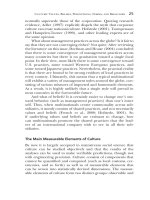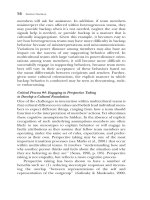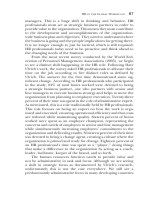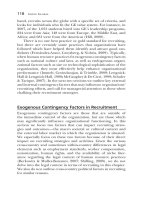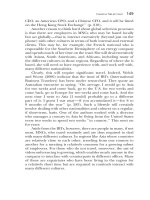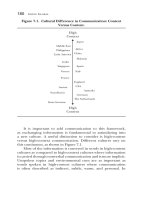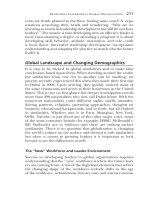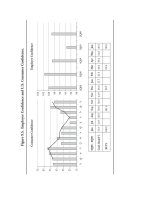Going Global Practical Applications and Recommendations for HR and OD Professionals in the Global Workplace J-B SIOP Professional Practice Series by Kyle Lundby, Jeffrey Jolton and Allen I. Kraut_8 ppt
Bạn đang xem bản rút gọn của tài liệu. Xem và tải ngay bản đầy đủ của tài liệu tại đây (535.19 KB, 28 trang )
Global Selection 159
being used, often with the wrong clients, in the wrong way, and
in inappropriate settings, it is worth assessing the current state of
the art in developing tests.
In a personal conversation with one of the authors in March
2009, a seasoned test development expert for an MNC testing firm
described the steps he takes to develop a test, along with some
of the pitfalls he faces. The following passage is based on this
discussion (S. Keely, personal communication, March 22, 2009).
Typically the first step in developing a new test is to determine
the goal. Often that will be to develop a test for an MNC that
wants to select 20 entry-level managers in 14 different countries.
These managers should be able to eventually advance in the
company, possibly even out of the country, so they should be
relatively equivalent to each other when selected. Making the test
equivalent across cultures is the challenge, so the following steps
should be considered:
1. Write the test in English (the MNC is based in an English-
speaking country, but as English is spoken by more managers
across the world than any other language, this is the norm
anyway).
2. Translate the test into the local languages for each country,
verbatim.
3. Revise the test to fit the local culture with the aid of an HR profes-
sional and a psychologist from that culture. Since there are many
differences between languages and cultures, there are always
problems here. First, some terms do not exist in some languages.
Even figuring out the Mandarin characters for words like ‘‘exec-
utive coaching’’ was difficult a few years ago when the term was
not common. Also in China, mentioning a personal checking
account in a numerical test will confuse people, so this terminol-
ogy must be avoided. Second, some concepts are simply under-
stood differently across cultures. For example, there is no such
thing as a ‘‘good loser’’ in Italian—a loser is a loser. Thus, a scale
measuring competitiveness may need revision to reflect that.
4. Back-translate the test. Using a bilingual (and ideally bicultural)
translator, translate the test back into English. This is best done
with a local psychologist, but one different from the one used in
the previous step to ensure there is no bias. As there are fluent
English speakers available in most countries, including those who
have been educated in English-speaking countries, this is not a
160 Going Global
problem. Usually the search for the appropriate person begins at
a local university’s psychology department.
5. Obtain norms for each country. This can also be done in
conjunction with the local university psychology department.
Standardizing the test and producing means and standard
deviations is done in this step. Note that just because an ethnic
group in two countries has the same language (and dialect)
does not mean that they will get the same norms. For example,
Chinese people in Mainland China tend to do better on
analytical reasoning tests than do Chinese outside Mainland
China. Norming is thus done for each country separately.
Cheung (2004) echoes the necessity for doing this step, noting
that ‘‘If interpreted directly according to the original norms,
test scores of Asian respondents [on personality tests] may be
misjudged to be deviant’’ (p. 180).
6. Validate the test for that population. This step is not always done.
Most local governments do not require it and it is costly and time
consuming. One way to get around this is to do concurrent valid-
ity studies. These are easier and less resource intensive for the
organization and can provide acceptable approximations for pre-
dictive validity.
7. Do equivalence studies. It is nearly impossible to have the same
cut-off scores for two different countries on the same test. How-
ever, doing this for validity generalization to establish a worldwide
norm sometimes works. The goal is to get the group to a reason-
able number for selection purposes.
These steps are summarized in Table 6.2.
Some of the problems faced when going through this process
include:
1. Technical problems—the script requires special programming
on the computer (for example, it is read up and down versus
side to side, or right to left, or it is created in characters or
script different from those of English).
2. Equivalence in dialects—is the MNC interested in Central
American Spanish or Spanishspokenin Spain? Kuwaiti or Saudi
Arabian Arabic? Traditional or Simplified Chinese characters?
Each dialect requires a different norm to be created as it cannot
be said that the speakers of that language are equivalent across
countries.
Global Selection 161
Table 6.2. Steps for Developing Culturally Valid, Standardized
Selection Tests.
#Step Notes
1 Write the test in English This is the global language of business
2 Translate the test into the
local language verbatim
Usually with the help of a local HR
professional or translation vendor
3 Revise the test to fit the
local culture
Usually with the help of a local HR
professional or psychology professor
4 Back translate the test Using a (different) local HR
professional or psychology professor
5 Obtain local norms for the
country
Often with the Psychology Department
of a local university or an assessment
vendor with experience in that country
6 Validate the test for the
local population
Generally not required by local
governments
7 Do equivalence studies for
different countries
Almost impossible to get the same
cutoff scores, but it is possible to
develop a global norm
3. With senior managers and executives, testing is not always used,
except for personality questionnaires.
4. Verbal reasoning tests do not work when translated into differ-
ent languages; thus, this is not done.
Since in this company’s experience it cannot be said that
any test is equivalent to the same test translated into another
language, testing is considered to be done locally only. For the
MNC mentioned above, the company would try to establish cutoffs
that were meaningful but this would have to be done on a
country-by-country basis. Thus, the MNC might not get complete
equivalence if it was trying to get the top 20 scorers among all
test takers. They may end up with five people each from three
countries, two from another country, and one each from three
others. Thus, among the 14 countries from which they were
selecting, the top 20 candidates may come from only 7. But
with the difficulties of getting equivalence across borders, the
162 Going Global
7 countries that were not represented may contain some of the
best candidates—they just did not do as well on the tests. Though
there is no easy answer on how to address this problem, another
tool that may help is assessment centers.
Designing Fair Tools—Assessment Centers, Context
and Culture
As testing is generally used for lower-level managers or entry-level
candidates, other tools are generally used for more senior can-
didates. Or, when testing is used, it is part of a larger process—
often an assessment center. An assessment center comprises
a number of different activities, usually including testing, an
interview, and various simulations. The simulations may include a
meeting with a direct report, a work group, a customer, or a boss,
along with an ‘‘inbox’’ or series of e-mails and memos to deal
with as part of a case study (Fisher, Schoenfeldt, & Shaw, 2003;
Gatewood & Feild, 2005).
The issues with transporting an assessment center across cul-
tural lines, largely involve the cueing for behaviors that either do
not exist in the second culture or behaviors that do exist, but
are evinced differently, as alluded to in the section above. For
instance, expecting negative feedback in a direct report meeting
in a Western, individualistic society is not out of the ordinary. An
effective manager in that scenario will give the negative feedback,
even if it is the first time she has met her ‘‘subordinate.’’ If she
shies away from doing that, it likely indicates a lack of managerial
skills. But to expect the same behavior in an Asian context, such
as in China, is to look for behavior that does not often appear
in real life. One of the authors has gotten consistent feedback
while assessing hundreds of managers in Greater China that the
first few times one meets a direct report (or just about anyone
else for that matter) the focus is on getting to know that per-
son and establishing a relationship, not changing their behavior.
In fact, in such a setting, it would be impolite and unnatural to
address shortcomings in behavior. Thus, an assessment center that
is developed around Western ideals may not work as intended in
an Asian context and may actually select for those who would not
be effective in the local culture.
Global Selection 163
Similarly, in a leaderless group discussion (LGD) mixing eth-
nic groups does not always work. HavingafewThaisamongagroup
of Americans and Germans will likely result in the Westerners
running the meeting and the Thais, from a more reserved and
less masculine culture (Hofstede, 2001), being nearly invisible.
This gives little data regarding the abilities of the Thais and would
not work when selecting for local positions in Thailand. Moreover,
even if the LGD were conducted with all Thai candidates, other
problems would appear, such as deference to the highest-ranking
person in the room. If the goal is to select for local leaders, the
LGD would provide some useful information but might still mask
the capabilities of the lower-ranking people in the room. At the
same time, it would not provide information on how the selected
local leaders would interact with those from headquarters in a
Western company.
With an inbox (IB) simulation, the same problems may appear.
With a reserved culture, few confrontations will occur and serious
problems may not be addressed. However, the most common
problem is generally one of language. Because the IB requires the
candidate to sort through a few dozen e-mails of varying lengths
and deal with the problems therein, all within one to one-and-a-
half hours, if the IB is not in his local language, the candidate
will have problems even finishing it. Again, this results in less
data available for assessment and generally a lower score on the
exercise. And even if he does finish, the recommended actions
which may work in an Asian culture may not make sense (and
therefore receive lower ratings) to Western raters. It should be
noted that in some cases, where it is obvious that the candidate had
problems with the language, the IB can be judged on the quality
ofworkdone,evenifitisasmallamount.Thiscansomewhat
mitigate the issue of the lack of data.
The interview may be problematic as well. Assuming the lan-
guage ability of the candidate is good enough to answer the
questions, an unfamiliarity with the process may hinder him from
giving useful answers to behavioral questions. This will likely disap-
pear as the use of behavioral interviews becomes more widespread.
However, the problem around appropriate behaviors for the cul-
ture may still remain; because the questions are written and scored
164 Going Global
by Westerners, behaviors that are proper in the local culture may
be scored lower than more Western-appropriate ones.
Other cultural issues may also have a negative impact on the
assessment center process. One is power distance (Hofstede, 2004)
which can be roughly thought of as the amount of hierarchy in a
cultural group. In cultures where there is a high power distance,
one might find that candidates are especially hard on their direct
reports and more subservient to their superiors. This will obviously
result in skewed findings in direct report meetings, IBs, and boss
meetings when compared to Western standards.
Context and culture. When companies enter emerging markets,
often local selection systems based on research studies are not
readily available. One possible reason for a lack of research-
based systems lies in the culture itself, namely an affinity for
nepotism and filial or tribal loyalty (Al-Aiban & Pierce, 1993;
Brand & Slater, 2003; Common, 2008). A nepotistic system would
invalidate selection devices such as interviews, personality tests,
and even skill-based tests because the results cannot be compared
to meaningful performance when promotions are not based on
merit. This is a particular problem in the Middle East and Africa.
As an example of the power of this system, consider the U.S.
troop surge into Iraq in late 2007. The surge may not have been
successful had the army not realized the importance of nepotism
in Iraqi tribal culture. Specifically, before and after the surge, U.S.
General David Petraeus implemented a policy of offering work
contracts to tribal elders (Sheikhs) in exchange for cooperation
against Al Qaida in Iraq (Woodward, 2008). What was different
about this system was the use of local tribal Sheikhs instead of
the centralized, merit-based bidding system used in the West. The
army had realized that Sheikhs would only work with the United
States if doing so could increase the Sheikhs’ own personal power,
which they measured by the number of followers they could
attract. The work contracts allowed leaders to attract and hire
additional followers within their own tribe, solidifying their local
status, and increasingthe appeal of working with the United States.
In contrast, nonmembers of the tribe were provided with little in
the way of job offerings, special assignments, promotions, and
subcontracts. Use of selection systems in this type of environment
may not even be tolerated, much less taken seriously. Trying to
force a merit-based selection system into a culture such as this
Global Selection 165
would result in, at best, a total lack of interest in applying for the
jobs among candidates.
This type of tribal loyalty extends into major corporations
as well, including a well-known Middle Eastern energy company
where two of the authors consulted. There, a multiyear attempt
to replace tribal and familial nepotism with a meritocracy has
been undertaken. Previously workers rose within the organization
based on a combination of personal influence and the influence
of individuals to whom they were related directly or via tribal
affiliation.Replacingsuchasystemwith tests and other measures of
merit is no small task.Administratorsareliterallyaskingindividuals
to change cultural norms and expectations while they are at work,
then return to them when they make their way home for the
night. Clearly this effort can impact interpersonal relationships
after work, which is a large obstacle to success in the project.
Another aspect of culture which may impact selection is level
of context. According to Hall (1976) cultures run on a continuum
between high and low context (see Table 6.3). This categorization
of cultures helps to determine how people relate to one anotheron
dimensions such as social orientation, commitment, responsibility,
confrontation, communication, and dealing with new situations.
Social bonds refer to how deeply involved people are with each
other. High-context cultures promote social bonds that imply
commitment, expectations, good will, conformity to group norms,
and greater distinctions between in-groups and out-groups (Hall,
1976, in Kim, Pan, & Park, 1998). Commitment is the degree to
which people do as they say in a culture. People in high-context
cultures consider their word to be their bond and therefore are
very reluctant to give it freely (Kim, Pan, & Park, 1998). However,
when they do give their word, it is, for all practical purposes,
as good as a written contract in Western culture. Responsibility
refers to how hierarchical and centralized decision making is in a
culture. High-context cultures see responsibility as being held at
the top, where subordinate errors are blamed on those who are
in charge. In low-context cultures, by contrast, responsibility and
decision making are diffused and therefore so is accountability for
errors (Kim, Pan, & Park, 1998).
Confrontation may be the most complex aspect of cultural
context. Due to the strength and intimacy of the bonds between
people in high-context cultures, confrontation is avoided, as
166 Going Global
alluded to above. Kim, Pan, & Park (1998, p. 511) indicate that
‘‘people are more likely to repress self feelings and interests to
maintain harmony, and there is a tendency to allow for con-
siderable bending of the system.’’ Additionally, to show emotions
such as anger or disagreement is to lose control; this causes a
loss of ‘‘face’’ which is directly related to reputation and honor
(Kim, Pan, & Park, 1998). On the other hand, acknowledging that
something has happened between yourself and another person in
a high-context culture requires that action be taken, and ‘‘action
is very, very serious’’ (Kim, Pan, & Park, 1998, p. 511). Similarly,
communication relies upon different things in high-context and
low-context cultures. In high-context cultures, messages are highly
economical and rarely contain all of the information necessary
to understand meaning. Instead, meaning is obtained by placing
the statements in the context from which they were derived, such
as who the communication was for and who it came from (for
example, higher- or lower-status individuals). Again, though this
is economical in that short messages can communicate a lot, it
does require a high level of ‘‘programming’’ to get to such a
point (Kim, Pan, & Park, 1998). Finally, people from low-context
cultures are used to the complexities of relying on context-free
systems and are therefore very creative even when dealing with
novel stimuli. Individuals from high-context cultures work well at
being creative within their contextual system, yet when confronted
with a situation outside of that system they must create a new one
before their innovation reaches its fullest potential.
China, Korea, and Japan tend to be high-context cultures;
Switzerland and Scandinavian countries such as Norway and Swe-
den tend to be low-context cultures; and France, Spain, Africa,
and the Middle Eastern countries all fall somewhere in the middle
(Kim, Pan, & Park, 1998).
Cultural context and effect on selection. When it comes to paper-
and-pencil job skill assessments there does not seem to be any
kind of link between context and score. Whether people are
from a high- or low-context culture, they will likely interpret
the questions the same way on a given test, all other things
being equal. However, in assessment center situations, such as
interviews and the assessment of softer skills or aspects such
as personality, context may play a key role in how individuals
Global Selection 167
Table 6.3. High-Context Versus Low-Context Cultures.
Issue High-Context
Cultures (HCC)
Low-Context
Cultures (LCC)
Result/Problems
Commitment Word is bond Written contract
necessary
Agreements can
be sealed verbally
with HCC
Responsibility Responsibility
for decisions is
held at top;
top-down
decision-making
Responsibility
for decisions is
diffused
Subordinate
errors blamed on
top for HCC; in
LCC everyone
has accountability
Confrontation Avoided given
intimacy of
bonds between
people
Done routinely
to ‘‘air
grievances’’
Bending of
system to ensure
no one loses face
in HCC
Communication Need
programming,
but can then be
economical
Must be
detailed and
precise; anyone
can understand
it regardless of
culture
Those outside the
HCC miss a lot of
what is
communicated
Creativity Need a system
to be creative
within; may
have to create a
new system
Potentially very
creative even
with novel
stimuli
HCC may have to
create a new
system to be truly
innovative
Source: Compiled from Hall, 1976, in Kim, Pan, & Park, 1998.
answer questions. For example, should an interviewer ask a job
candidate to critique a piece of work as part of a skills assessment,
the lack of context in such a situation may lead the job candidate
to keep quiet for fear of appearing sassy, abrasive, or causing a loss
of face for a superior who may have done the work. In simulations,
the person from a high-context culture may view the situation
from his own cultural context and respond accordingly. Where
the simulations are created in a low-context culture, then, they
may elicit the wrong cues. For example, in the Middle Eastern
168 Going Global
energy company mentioned above, one of the simulations used
was a meeting with the candidate’s peer. While the low-context
competencies were cued for in the simulation, typical responses
by the candidates were all around developing relationships. In
a high-context culture, relationships are very important (Hall,
1976). Moreover, since all of the assessors were Westerners, it is
likely that many of the high-context cultural messages were missed.
For both reasons, the use of that particular assessment process
might be questioned. However, as discussed above, this project
was intended to wrench the company into a flat world; hence,
different cultural norms were considered more appropriate than
the local norms. As noted above, the use of local norms resulted
in the promotion of managers on the basis of affiliations rather
than merit. This, it was felt, would eventually cripple the company
since the senior management was seen as increasingly less capable
(and through the nepotistic system, even lacking the incentive to
become capable).
The promotion process may be where context and other
aspects of culture such as nepotism and familial or tribal loyalty
play their most important role in selection systems. Most Western
promotion systems assume that performance in the current job
predicts performance in the job to which a person is being
promoted. However, little research has been conducted on this
assumption and what has been done does not seem to support it
(see Bernardin, 2009).In fact, in high-context cultures, individuals
who hold their own feelings in check communicate in acceptable
ways that do not cause others to lose face (Kim, Pan & Park, 1998).
This helps to avoid causing problems related to responsibility
because that person is able to avoid making errors and conform
to group requirements. As a result, these individuals may be more
likely to be rewarded for their loyalty than others who do not act in
this way. This has little to do with merit but everything to do with
what is prized in a good (that is, docile) worker. In fact, it usually
results in little challenging of the system, because avoiding errors
and not speaking up against bad ideas from others does not allow
for it. In addition, in cultures where nepotism and familial or
tribal loyalty are high, it is even less important how well a person
does in their current job so long as they are properly connected at
the next level and do what they need to do to fit in (Brett, 2007).
Global Selection 169
Thus, the entire concept of merit may be turned on its head.
A high-context assessment center may be better off measuring
who ‘‘gets’’ the cultural mores most effectively to ensure those
candidates are promoted. However, as Friedman (2005) suggests,
those cultures may also be left behind in the flattening world:
‘‘What is the motto of the tribalist? ‘Me and my brother against my
cousin; me, my brother and my cousin against the outsider.’ And
what is the motto of the globalist ? ‘Me and my brother and my
cousin, three friends from childhood, four people in Australia, two
in Beijing all make up a global supply chain’’’ (p. 326). This is
an argument for merit-based assessment, regardless of which local
culture is involved. As such, it is a step toward equal measurement
of TN capabilities.
What to Do?
To ensure that cultural factors do not negatively affect assessment
results, there are a number of steps that can be taken. First,
there must be a competency modeling project completed to
clarify what is to be measured, both for the position in the home
country and the same position to be filled in the host country.
Where there are differences, there should be a conversation
by stakeholders about what is important for the host country
position and what the expectations are for the person who fills
the position. For instance, is that person expected to stay in-
country or move out of the country as her career progresses? As
noted above, this will have implications for the knowledge and
skills needed. Including the requisite competencies to select TNs
versus expats versus domestic employees is therefore important.
Currently researchers are examining the particular competencies
that should be assessed, usually just regarding expats (see Harzing,
2004), but at present there is no agreement on exactly what those
competencies should be.
Second, when there is agreement on what the position should
require, the assessment should be designed or modified to reflect
those needs. If the needs are for a TN to take on the position,
then a process that reflects the corporate culture rather than the
local culture should be used. If the person is expected to remain
in-country for most of her career, then the process should be
designed around and reflect the local culture.
170 Going Global
Third, once the process is modified to fit the aims of the
center, it is necessary to pilot it. Comments should be solicited
on everything, including such details as the names for the players
in the cases. One way to do this is to select some internal staff
from the relevant culture and request input from them on the
simulations and interview. One manager from Shell for example,
says that in that company, they use focus groups with which to try
out a new exercise or process (Sparrow et al., 2004).
Fourth, the assessment process should be validated. This can
be done by examining results of the center for individuals against
the later progress of those individuals in the company. Of course,
this is not an ideal solution because in the vast majority of cases,
companies use the data to make selection decisions (as is the
goal here). Thus, the data used to validate the center is clearly
biased and thus not entirely useful (Gatewood & Feild, 2005).
Most companies, moreover, will not put the data aside for a few
years to determine the validity of the center; such action would be
too costly and would not help the organizations make selection
decisions, which again is the point of the exercise. Nonetheless, a
validation effort should be attempted.
Fifth, a consistent reevaluation of the assessment process
should take place periodically. Even national cultures now are
changing as globalization gathers steam, and the needs of com-
panies often change as quickly. It is imperative that the process
measure accurately and according to the needs of the organi-
zation. To risk assessing the wrong person for the wrong job
in the wrong culture may be extremely expensive, not only in
cash, but also in negative publicity and the loss of a valuable
resource—namely, some of the organization’s talent.
Finally, it is possible that as national cultures change, peo-
ple are even choosing their own culture (Tipton, 2009). This
may complicate the development of tests and assessment centers
but also may make it easier. If companies can create a culture
that draws people in, perhaps like those of some of the dot-
coms, then the assessment tools can simply be made to reflect
the company culture and a person’s fit with that culture, rather
than having to determine fit with the local and corporate cul-
tures, along with any other cultures in which a TN might find
himself.
Global Selection 171
Conclusion
In this increasingly globalized world, itisbecomingmoreandmore
important to find, hire, and develop people who can movebetween
cultures freely and easily while remaining productive and advanc-
ing the organization’s goals. Although many researchers have
spent significant time exploring the issues surrounding expats,
another type of corporate nomad, the transnational (TN) has
become a growing part of the global workforce, and increasingly
important to MNCs. Thus, TNs must be considered when deciding
on which selection tools to develop and how to develop them. The
growing numbers of both TNs and expats, moreover, requires the
development of tools including testing and assessment centers
that are culture appropriate and fair. We have attempted to show
in this chapter that these problems are neither gigantic in size
nor Lilliputian in scope. Instead, they simply require a logical,
if more complex, consideration of the variables involved and a
willingness to step out of one’s own culture to consider the more
long-term goals of the organization and of the individuals within
that organization.
References
Adler, N. J., & Bartholomew, S. (1992). Managing globally competent
people. The Academy of Management Executive, 6(3), 52–65.
Al-Aiban, K. M., & Pearce, J. L. (1993). The influence of values on
management practices. International Studies of Management and Orga-
nization, 23(3), 35–52.
Anderson, N., Lievens, F., van Dam, K. & Ryan, A. M. (2004). Future per-
spectives on employee selection: Key directions for future research
and practice. Applied Psychology: An International Review, 53(4),
487–501.
Bartram, D. (2001). The development of international guidelines on
test use: The International Test Commission project. International
Journal of Testing, 1(1), 33–54.
Bernardin, H. J. (2009). Human resource management: An experiential
approach (5th ed.). New York: McGraw-Hill/Irwin.
Brand, V., & Slater, A. (2003). Using a qualitative approach to gain
insights into the business ethics experiences of Australian mangers
in China. Journal of Business Ethics, 45(3), 167–182.
172 Going Global
Brett, J. M. (2007). Negotiating globally: How to negotiate deals, resolve disputes,
and make decisions across cultural boundaries (2nd ed.). San Francisco:
Wiley.
Briscoe, D. R., & Schuler, R. S. (1995). International human resource
management (2nd ed.). New York: Routledge.
Brookfield Global Relocation Services, National Foreign Trade Council
(2008). Global relocation trends: 2008 survey report. Brookfield Global
Relocation Services, LLC, Woodridge, IL.
Caligiuri, P. M. (2000). Selecting expatriates for personality characteris-
tics: A moderating effect of personality on the relationship between
host national contact and cross-cultural adjustment. Management
International Review, 40, 61–81.
Caligiuri, P., & Paul, K. B. (2010). Selection in multinational organiza-
tions (Chapter 34). Refereed book chapter in James L. Farr and
Nancy T. Tippins (Eds.), Handbook of employee selection. Hillsdale,
NJ: Erlbaum.
Caligiuri, P., & Tarique, I. (2006). International assignee selection and
cross-cultural training and development. In Gunter K. Stahl &
I. Bjorkman (Eds.), Handbook of research in international human
resource management. Northampton, MA: Edward Elgar Publishing.
Cerdin, J. L., & Bird, A. (2008). Careers in a global context. In Michael
M. Harris (Ed.), Handbook of research in international human resource
management. Hillsdale, NJ: Erlbaum.
Cheung, F. (2004). Use of western and indigenously developed person-
ality tests in Asia. Applied Psychology: An International Review, 53(2),
173–191.
Chua-Eoan, H. (2007). Crimes of the century: The collapse of Barings
Bank, 1995. Time.com. Retrieved August 8, 2009 from www.time
.com/time/2007/crimes/18.html.
Common, R. (2008). Administrative change in the Gulf: Modernization
in Bahrain and Oman. International Review of Administrative Sciences,
74(2), 177–193.
Enron scandal at-a-glance. (2002). BBC. Retrieved on August 8, 2009,
from />Fisher, C. D., Schoenfeldt, L. F., & Shaw, J. B. (2003). Human resource
management (5th ed.). Boston: Houghton Mifflin.
Forster, N. (2000). The myth of the ‘‘international’’ manager. The
International Journal of Human Resource Management, 11(1), 126–142.
Forster, N. (1994). The forgotten employees? The experiences of expatri-
ate staff returning to the UK. International Journal of Human Resource
Management, 5(4), 405–27.
Global Selection 173
Friedman, T. L. (2005). The world is flat: A brief history of the twenty-first
century. New York ; Farrar, Straus & Giroux.
Gatewood, R. D., & Feild, H. S. (2001). Human resource selection (5th ed.).
Cincinnati, OH: South-Western.
Goodwin, R. (1999). Personal relationships across cultures. Routledge:
London. Retrieved from: />KwMCG0hahEcC&lpg=PT154&ots=lxIGnOi8Te&dq=social%20
networks%20collectivist%20cultures&pg=PT154#v=onepage&q
=social%20networks%20collectivist%20cultures&f=false.
Hall, E. T. (1976). Beyond Culture.NewYork:AnchorBooks.
Harter, J. K., Schmidt, F.L., & Hayes, T. L.(2002). Business-unit-level rela-
tionship between employee satisfaction, employee engagement,
and business outcomes: A meta-analysis. Journal of Applied Psychology,
87(2), 268–279.
Harzing, A. (2004). Composing an international staff. In A. Harzing &
J. Van Ruysseveldt (Eds.), International human resource management.
New Delhi: Sage.
Hewitt Associates (2004). Research brief: Growing great leaders key to
double digit growth. Retrieved from www.hewittassociates.com/
MetaBasicCMAssetCache /Assets/Articles/DDGLeadershipfull
.pdf.
Hofstede, G. (2004). Cultures and organizations: Software of the mind (2nd
ed.). New York: McGraw-Hill.
Hofstede, G. (2001). Culture’s consequences: Comparing values, behaviors,
institutions and organizations across nations (2nd ed.). Thousand
Oaks, CA: Sage.
International Test Commission (2000). International guideless for test
use, version 2000. Retrieved from www.intestcom.org/Downloads/
ITC%20Guidelines%20Download%20Version%204.doc.
Kim, D., Pan, Y., & Park, H. S. (1998). High- versus low-context cul-
ture: A comparison of Chinese, Korean, and American cultures.
Psychology & Marketing, 15(6),507–521.
Kingsbury, K. (2009, August 8). Hong Kong 1997–2007. Time.com.
Retrieved from www.time.com/time/specials/2007/article/0,
28804,1630244
1630282 1630193–1,00.html.
Lievens, F., & Thornton, G. C. (2005). Assessment centers: Recent
developments in practice and research. In A. Evers, N. Anderson,
&O.Voskuijl(Eds.),The Blackwell Handbook of Personnel Selection.
UK: Wiley-Blackwell.
Lowe, K. B., Milliman, J., de Cieri, H., & Dowling, P. J. (2002). Interna-
tional compensation practices: A ten-country comparative analysis.
Human Resource Management, 41(1). 45–66.
174 Going Global
Mesmer-Magnus, J. R., & Viswesvaran, C. (2008). Expatriate manage-
ment: a review and directions for research in expatriate selection,
training and repatriation. In M.M. Harris (Ed.), Handbook of Inter-
national Human Resource Management (pp. 183–206). Hillsdale, NJ:
Erlbaum.
Moorhead, G. I. (2010). Organizational behavior: Managing people and
organizations (9th ed.). Mason, OH: South-Western. Retrieved
from: />PT65&ots=TPmW2eYm9S&dq=global%20workforce%20changes
%20diversity%20statistics&pg=PT65#v=onepage&q=global
%20workforce%20changes%20diversity%20statistics&f=false.
Oakland, T. (2004). Use of educational and psychological tests interna-
tionally. Applied Psychology: An International Review, 53(2), 157–172.
Perkins, S. J., & Shortland, S. M. (2006). Strategic international human
resource management (2nd ed.). London: Kogan Page.
Ryan, A. M., & Tippins, N. (2009). Designing and implementing global
selection systems. West Sussex, UK: Wiley-Blackwell.
Ryan, A. M., Wiechmann, D., & Hemingway, M. (2003). Designing
and implementing global staffing systems: Part II—best practices.
Human Resource Management, Spring 2003, 42(1), 85–94.
Sparrow, P., Brewster, C., & Harris, H. (2004). Globalizing human resource
management. New York: Routledge.
Suutari, V. (2003). Global managers: Career orientation, career tracks,
life-style implications. Journal of Managerial Psychology 18(3),
185–207.
Tipton, F. B. (2009). Modeling national identities and cultural change.
International Journal of Cross Cultural Management, 9(2): 145–168.
Toosi, M. (2002). A century of change: The U.S. labor force 1950–
2050. Monthly Labor Review. Retrieved from www.bls.gov/opub/
mlr/2002/05/art2full.pdf.
Vance, C. M., & Paik, Y. (2006). Managing a global workforce.London:
M.E. Sharpe.
Welch, D. E., & Worm, V. (2006). International business travelers: a
challengeforIHRM.InGunterK.Stahl&I.Bjorkman(Eds.),
Handbook of research in international human resource management.
Northampton, MA: Edward Elgar.
Wiechmann, D., Ryan, A. M., & Hemingway, M. (2003). Designing and
implementing global staffing systems: Part I—leaders in global
staffing. Human Resource Management, Spring 2003, 42(1), 71–83.
Woodward, B. (2008). The war within: A secret White House history
2006–2008. Simon & Schuster: New York.
CHAPTER 7
On-Boarding in a Global
Workplace
Mary Plunkett
The author would like to gratefully acknowledge the
contributions of Rod Magee.
The Challenge
Although research and common sense tell us that it is wise to invest
in preparing employees to be successful in their jobs, this challenge
is intensified in today’s global business reality. The recent world-
wide economic crisis is demonstrating just how global the world
economy has become. According to the United Nations the num-
ber of multinational corporations has more than doubled in the
past 10 years. Today there are more than 60,000 firms deriving at
least a quarter of their revenue from operations outside their home
country (Buckley & Ghauri, 2004). Assuming an average employee
turnover rate of 15–20%, there will always be new people enter-
ing into organizations. Historically, new employees—especially
senior-level hires—received little more than a basic orientation to
their new company. Today’s business environment, which requires
maximum productivity at minimum cost, has forced reconsidera-
tion of the once prevailing mind-set that good, smart people know
what to do and can find their way around. New employees can
be brought into organizations more efficiently and effectively, a
process now commonly referred to as on-boarding.
175
176 Going Global
Table 7.1. On-Boarding Defined.
Align Make sure your organization agrees on the need for a
new team member and the delineation of the role you
seek to fill.
Acquire Identify, recruit, select and get people to join the team.
Accommodate Give new team members the tools they need to do work.
Assimilate Help them join with others so they can do work together.
Accelerate Help them (and their team) deliver better results faster.
A comprehensive on-boarding process begins with recruitment
and extends well beyond entry into the organization. It is critical
to design on-boarding practices from the perspective of the new
employee, focusing on the individual’s efficient, effective, and
emotional transition into the organization. As shown in Table 7.1,
the most recent and holistic definition of on-boarding describes it
as the process of aligning,acquiring,accommodating,assimilating,
and accelerating new team members whether they come from
inside or outside the organization (Bradt & Vonnegut, 2009).
The unfortunate truth is that most organizations are not
adept at on-boarding employees; the good news is that although
proper on-boarding requires time and attention, the process itself
is not complicated. Further, research by the Aberdeen Group
(2006) shows that as many as 75% of the 600 companies surveyed
implement or planned to implement a formal on-boarding process
by 2010. For every step in the process, there are integrated
accountabilities for the newcomer, the newcomer’s line manager,
and HR professionals. This chapter is written for line managers
and those responsible for designingand implementinganeffective
on-boarding approach for new team members within a global
organization.
The Bottom Line
To enhance competitiveness, organizations are regularly hiring
new employees or relocating employees from one function or
geography to another. These individuals have a mandate for
change, but unfortunately many don’t meet expectations and
On-Boarding in a Global Workplace 177
are forced to leave the organization. The Corporate Leadership
Council (2006) reported that 30–50% of newly hired execu-
tives fail or are ‘‘derailed’’ within three years. Bradt, Check, and
Pedraza (2006) suggest that as many as 40% of leaders going into
new organizational roles fail during their first eighteen months.
Another study reports that up to 64% of new executives hired from
outside the company will fail at their jobs, nearly twice the rate
of those failing who have been promoted from within (Ciampa
& Watkins, 1999). The costs of failure can be staggering. The
direct costs of a failed executive-level hire—including recruit-
ment, relocation, compensation, and severance—could be three
to four times base salary (Bossert, 2004). But factoring in indirect
costs such as lost opportunities, business delays, and damage to
customer and staff relationships can push this number to 20 times
salary! (Watkins, 2003).
Providing formal on-boarding processes for new employees
helps mitigate the risk of failure. Equally important, on-boarding
is also a vehicle for enhancing an employee’s engagement to
the organization and a means of reducing the time necessary
to become productive. Statistics regarding productivity gaps for
individuals in assignments outside of their home company are
sparse. International assignments present a unique combination
of challenges related to the individual and his or her family
unit, adding to the complexity of effectively assimilating into role.
Research that has been conducted on effectively transitioning into
roles, not considering the international component, suggests that
it takes a mid-level manager 6.2 months to reach the point where
contribution to the organization begins to surpass the company’s
cost of bringing the person onboard (Watkins, 2003). For senior
leaders it can take as long as 2.5 years to completely assimilate into
a new organizational context (Gabarro, 1987).
On-Boarding’s Foundation: Socialization
The underlying element of an effective on-boarding process is
socialization, broadly defined as the process through which an
individual acquires the attitudes, behaviors, and knowledge nec-
essary to successfully become an organizational member (Van
Maanen & Schein, 1979). Employees enter into a new organiza-
tion or new function or geography of their existing organization
178 Going Global
with a lot of uncertainty; for example, how will performance be
evaluated, what personal relationships are critical, what behav-
iors are normative (Miller, 1996)? Effective socialization reduces
these uncertainties. An employee who is successfully socialized
will dependably perform job tasks and contribute to achieving the
goals of the organization. The individual will demonstrate motiva-
tion, organizational attachment and commitment, and overall job
satisfaction (Allen, 2006).
Socialization is not a single event. Rather, socialization is the
iterative process between the new employee and the organization
as the individual develops skills, knowledge, role behavior, and
adjustment to norms and values in response to needs and expec-
tations of organization (Smith, 1989). New employees develop an
understanding of several key areas through socialization as shown
in Table 7.2.
Multicultural Socialization
As more and more organizations expand beyond their home coun-
try boundaries, the importance of effectively on-boarding new
Table 7.2. Key Areas Developed Through Socialization.
Task Knowledge Learning and mastering the knowledge, skills and
abilities to perform required work tasks
Relationships Establishing successful and satisfying work
relationships with managers, direct reports, peers,
customers, and other key organizational
stakeholders
Politics Gaining information regarding formal and informal
work relationships and power structures
Language Understanding industry language as well as
acronyms and jargon unique to the organization
Values/Norms Understanding the rules and principles that
maintain the integrity of the organization
History Learning the organization’s historical roots,
traditions, customs, background of key
organizational members
On-Boarding in a Global Workplace 179
team members is heightened and becomes more challenging.
To be maximally effective, on-boarding programs need to be
customized for each individual in the context of the role, the
business and industry, the financial state of the business, and its
organizational culture. There is little research that specifically
addresses on-boarding practices in global organizations, but a
recent survey by Korn/Ferry reported that only 30% of global
executives were satisfied with their employee’s on-boarding pro-
cess (Pomeroy, 2006). Further, the most commonly cited reason
for new employee failure is the inability to adapt to the orga-
nization’s culture, and multinational organizations by definition
represent many diverse cultures (Scullion & Collings, 2006).
Organizational culture has been defined as the ‘‘normative
glue’’ that holds an organization together (Tichy, 1983). Commu-
nicating cultural values and accepted behaviors is an important
aspect of achieving organizational outcomes. In a study of 46
global executives who recently changed jobs, one-third needed a
year to ‘‘adjust,’’ with 75% citing the organizational culture as the
biggest barrier to adjustment (Dai & DeMeuse, 2007).
Culture is a critical component to an on-boarding process as
new employees entering into multinational corporations need to
understand corporate and local expectations, norms, and values.
(See Chapter 2 for more information on culture.) A clear under-
standing of cultural elements will allow individuals to evaluate
their behavior and make necessary corrections, if needed (McCall
& Hollenbeck, 2002).
A useful framework for beginning to understand cultural
differences is provided by Stephen Rhinesmith (1996). This broad
framework includes analyzing:
1. How people perceive themselves as individuals or as part of
collective group.
2. How people perceive their relationships with others in terms
of formality, depth, and obligations.
3. How people perceive the world around them, including rela-
tionship with nature and attitudes toward time and space.
4. How people think, including problem solving, linear versus
holistic, inductive versus deductive reasoning.
180 Going Global
Figure 7.1. Cultural Difference in Communication: Context
Versus Content.
High
Context
High
Content
Japan
Africa
Middle East
Philippines
China
Latin America
India
Singapore
Greece
Spain
Italy
Malaysia
France
Swiss Germans
England
Austria
USA
The Netherlands
Germany
Australia
Scandinavia
It is important to add communication to this framework,
as exchanging information is fundamental to assimilating into
a new culture. A useful distinction to consider is high-content
versus high-context communication. Different cultures vary on
this continuum, as shown in Figure 7.1.
Most of the information is conveyed in words in high-content
cultures as compared to high-context cultures where information
is carried through nonverbal communication and is more implicit.
Unspoken topics and environmental cues are as important as
words spoken in high-context cultures where communication
is often described as indirect, subtle, warm, and personal. In
On-Boarding in a Global Workplace 181
contrast, high-content cultures are experienced as more direct,
impersonal, objective, and logical (Hall, 1976).
A comprehensive on-boarding approach focuses on bringing
the new hire up to speed on the internal culture of the orga-
nization and the local culture. Table 7.3 shows a list of specific
elements that contribute to the culture of an organization.
Table 7.3. Elements That Contribute to Organizational Culture.
Awards and
Ceremonies
How are employees recognized for performance? Are
there service awards or retirement events?
Social Events Are there routine informal events, such as
informal gatherings at local pub, or sporting
events?
Customer
Focus
To what extent does the organization value customer
service (versus production or sales)?
Decision
Making
Does the organization tend toward consensual decision
making? Are decisions usually made at the senior level
and distributed throughout the organization?
Dress Code Is the dress code formal or more casual?
Feedback Does feedback occur frequently and informally, or
more formally during scheduled sessions?
Information
Dissemina-
tion
How much information about the business is shared
throughout the organization? How is information
disseminated throughout the organization:
electronically, in meetings, one on one?
Leadership
Style
What is the style of senior leaders: are they autocratic,
participative, heroic, or accessible?
Physical
Environment
What does the typical working environment look like?
What is the work space of senior leaders?
Speed What is the sense of urgency in the company, to
respond to e-mails, telephone messages, work tasks?
Training What is the type and frequency of training provided to
employees?
Work Hours When are employees typically in the office? Are
employees expected to work weekends, holidays?
182 Going Global
The new hire’s line manager and colleagues play an important
role in articulating the internal culture of the organization. This
can be effectively accomplished by sharing stories that convey what
it is really like to work at your company. Written materials such as
policy manuals, internal newsletters, memos from senior leaders,
press releases, and so on should be gathered and shared with the
new hire as these can also help describe the unique personality
of the company and its local operations. Line managers and
colleagues and people from the new hire’s country of origin
are also instrumental in describing the local culture. Additional
sources of information such as history books, local art, traditional
foods, holiday celebrations, and the like can be very informative
about the norms and values of the local culture. Be explicit to
include local cultural aspects as well as internal company norms
when reviewing the elements shown in Table 7.3.
Stages of On-Boarding
Because socialization is the foundation of effectively on-boarding
new employees, or individuals new to role, we will illustrate
on-boarding practices according to the stages of socialization:
Anticipatory, Accommodation, and Role Management (Feldman,
1976). Anticipatory socialization occurs before an employee enters
the organization. This stage involves practices related to getting
into the organization. Accommodation socialization occurs as the
individual enters the organization and begins to understand what
the organization is really like and attempts to become a partic-
ipating member. In the role management stage of socialization,
the individual masters work tasks, settles into the job role, and
becomes a contributing member of the organization.
Stage 1: Anticipatory or Pre-Entry
Research has shown that the attitudes that newcomers develop
toward their new employer form very early and are relatively stable
over time (Bauer & Green, 1994). This highlights the importance
of paying attention to every detail associated with the candidate
selection process as the first stage of on-boarding. New employees
begin to develop an impression of the organization based on the
On-Boarding in a Global Workplace 183
professionalism of interactions with recruiters and organizational
members. Individuals involved in recruiting and interviewing pro-
cesses need to provide candidates with a realistic view of the role,
the challenges he or she will likely face, and, most important, a
glimpse into the culture of the organization. They need to make
candidates feel comfortable and welcome while gaining informa-
tion necessary to make an accurate assessment of the candidates’
skills and degree of ‘‘fit’’ within the organization.
Structured interviews are a valuable tool for assessing a candi-
date’s organizational fit; the results from these interviews can be
an indicator of the individual’s success or failure in role (Lomax,
2001). Structured interviews designed to assess organizational fit
should focus on character traits deemed essential by the company.
For individuals moving to roles outside their home company, traits
such as openness to experience, flexibility, persistence, and empa-
thy have been identified as key predictors of the individual’s
performance in role (McCall & Hollenbeck, 2002).
GlaxoSmithKline has institutionalized a ‘‘Candidate Care’’
model which is a process and prescribed set of behaviors that
applies a customer service model to candidates’ recruitment expe-
riences. Treat prospective employees in the same manner as your
valued customers, not as traditional job applicants. Ensure that
all applicants, those who successfully gain employment and those
who do not, have a positive story to share with others. Lou Manzi,
vice president of global recruitment, views GSK’s candidate care
process as a competitive advantage, one that enhances GSK’s rep-
utation as a preferred employer while increasing the firm’s brand
equity.
Practical steps for global hiring managers include the
following:
• Provide each applicant with a positive and realistic understand-
ing of the company
• Excite them about your brand by clearly and concisely describ-
ing what your firm stands for
• Involve people from diverse perspectives (that is, nationalities,
functions, tenure) in the interview process
• Don’t overpromise and underdeliver


